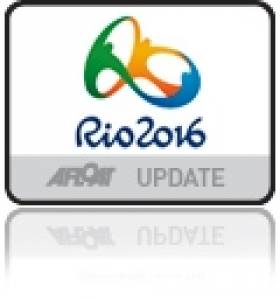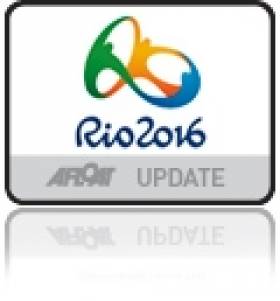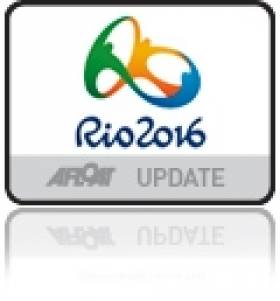Displaying items by tag: ISAF Worlds
Irish Improve In ISAF World Rankings After Santander
#Santander2014 - With the last races sailed at the 2014 ISAF Worlds in Santander, the biggest plaudits are going to the new world champions who've seen their stock rise in the global rankings.
But they're not the only ones with reasons to celebrate, as Ireland's sailing team have added to their impressive performances in Spain last week with a strong showing in the latest world sailing tables announced today (23 September).
Not content with being Ireland's first Olympic qualifier, James Espey has jumped four places in the Men's Laser rankings from 62nd to 58th. But he's not even the biggest riser among the Irish.
That accolade goes to Laser prospect Finn Lynch, who didn't have much to write home about in Santander but still rocketed from 296th in the world to 194th: a remarkable improvement of 102 places. Well done, Finn!
Andrea Brewster and Saskia Tidey may have narrowly missed out on Olympic qualification in the 49erFX, but they've jumped two placed in the world table from 29th to 27th – not bad at all for the development duo who've only been sailing together for a year.
Holding steady, meanwhile, are Rio-bound Annalise Murphy at 18th place in the world Laser Radial rankings, and Ryan Seaton and Matt McGovern, who are just one spot off the world top 10 in the 49er class.
It wasn't the best performance for independent Irish sailor Ross Hamilton, who slipped two places from 59th to 61st in the Finn class, but he will have further opportunity to improve his position and stake claim on a coveted spot in Rio for the 2016 Olympics.
Ryan Seaton & Matt McGovern Are Rio Bound Making 49er Top 10 At ISAF Worlds
#Santander2014 - Ryan Seaton & Matt McGovern are the third and fourth Irish sailors to clinch their spots for Rio 2016 on Day 8 of the ISAF Worlds in Santander, joining James Espey and Annalise Murphy among those already bound for Brazil.
Despite still having one more race to go tomorrow (20 September) in the 80-boat 49er class, the Northern Irish pair have built enough of a points gap to secure a coveted top 10 nation place in the 49er class.
Only 10 places are up for grabs in Santander by the top nations from a competing pool of 33. But the Northern Irish pair, who previously sailed at London 2012, knew that to qualify for Rio at this early stage would significantly ease the pressure.
Upon hearing the news, Seaton said: “Getting the qualification for Rio is a big boost for us. It’s one box ticked but we still have a job to finish. We’re here to get a medal so we’ve still got to keep pushing hard."
McGovern added: “Now we can focus on events in Rio rather than having to compete in Europe at the other qualifiers. From a preparation point of view it makes things a lot smoother”.
Seaton and McGovern made waves when they began competing in Santander earlier this week, finishing second in their opening race and quickly stationing themselves at the top of the leaderboard.
After the initial two days of the qualifying series, the pair qualified with ease for the Gold Fleet. From there they have remained in sixth place overall and sixth nation.
After two races today it was confirmed that they had enough of a points lead to have earned Ireland yet another Olympic place. They will have one final Gold Fleet race tomorrow before the top 10 boats progress to Sunday’s medal races, where they’ll battle it out for the 49er world title.
Meanwhile, in today's 49erFX Gold Fleet, Andrea Brewster and Saskia Tidey had a physically and mentally gruelling four races. The pair capsized in the first race and were unable to finish. Things did not improve too much with a 25, 19 and 20.
However, they will have one final shot at Olympic qualification tomorrow where they must be among the top 10 nations. The pair are currently 14th nation.
Andrea Brewster & Saskia Tidey Qualify For Gold Fleet At 2014 ISAF Worlds
#Santander2014 - Both of Ireland’s 49er teams pulled out the necessary results on Day 7 of the ISAF Sailing World Championships to stay in contention for Olympic qualification.
Andrea Brewster and Saskia Tidey qualified for the female 49erFX Gold Fleet while their teammates Ryan Seaton and Matt McGovern moved up to sixth overall in the 49er Gold Fleet.
Today was the final day of the qualifying series for the 55 boats in the 49erFX fleet. Brewster and Tidey had a fifth and a sixth, which boosted them significantly from 35th overnight to 17th, and meant they made Gold Fleet along with the other top 24 teams.
The ISA development sailors will now fight it out with the 14 other nations in Gold to try and secure one of the 10 coveted Olympic spots available.
Commenting after racing, Brewster said: “We needed to have two really good races today and we nailed it.”
Tidey added: “It was really gusty but we found all our skills were really good on the course. Everything we’d been practising really paid off and we’re so thrilled with today.”
Meanwhile, Seaton and McGovern last night finished the 49er qualifying series in 12th position, making the cut for their class Gold Fleet.
In order to earn Ireland another place at Rio 2016, the Northern Irish pair must also finish the regatta within the top 10 nations. A total of 88 teams from 33 nations are competing in the men’s skiff class so every result counts.
Sailing in 20 knots this afternoon, the boys warmed up with an 11th in Race 6. From there they kept on an upward trajectory with a ninth in Race 7, followed by a sixth in Race 8 and finally a second in Race 9. These solid results were enough to move them up three places in the leader board to sixth overall.
ISA performance director James O’Callaghan said it was “a really solid day from the skiff teams today. Both are now really well positioned going into Gold and the fight to secure nation qualification."
Watch The Laser & Laser Radial Medal Races At The ISAF Worlds LIVE NOW
#Santander2014 - The medal races in the Laser and Laser Radial classes at the 2014 ISAF Worlds in Santander are being broadcast worldwide via YouTube right now.
Follow all the action via the embedded video above and see the course where Annalise Murphy and James Espey have secured their Olympic dream tickets to Rio.
Annalise Murphy Secures Her Rio 2016 Spot At ISAF Worlds
#Santander2014 - Annalise Murphy became the second sailor to qualify Ireland for the 2016 Olympics on Day 6 of the 2014 ISAF Worlds in Santander, placing 20th overall and 16th on the nations table - well within the top 19 that earned their country the chance compete in Rio.
“I started the regatta pretty badly so it was difficult to back out on the second day and make Gold Fleet," she said after the day's racing. "But I had a really good day and then continued to claw my way back up the fleet."
She continued: “My primary goal for competing here was to win a medal but my secondary goal was to qualify to county. Unfortunately I didn’t quite reach my first goal but it’s great to have been able to qualify Ireland in the Laser Radial.”
The 23-year-old from Rathfarnham had a mixed performance in Santander, the first Olympic qualifier where half of all places in Rio were awarded. Her results ranged from a fifth to a 43rd in what were light conditions for the majority of the regatta.
Today (Wednesday 17 September) was the final day of racing and the final chance for Murphy to qualify. Overnight she was 28th individually and 21st nation so everything hinged on her performance in today’s scheduled three races.
The wind had arrived by this morning, averaging about 20 knots. With no room for error, Murphy went straight to the top the fleet in the first race of the day. Neck-and-neck with the world’s best, she crossed the finish line in 13th place – exactly what she needed boosting her up to 20th overall and 16th nation.
Two further races had been scheduled but at 6.05pm local time the decision was made to cancel due to the lack of wind.
ISA high performance director James O’Callaghan said of her achievement: “While the overall result was not her best, you can’t but be impressed with the way Annalise fought back after a disastrous first day. We are delighted with nation qualification."
Elsewhere, there was a sense of déjà vu for Ryan Seaton and Matt McGovern in the 49er. The pair had been reseeded to the Yellow Fleet but matched yesterday’s results with a 2nd and a 15th.
One further race will have to be sailed tomorrow by the Blue Fleet in order to make a qualifying series. At that time the overall positions will be known and the Gold and Silver Fleet cut will be made.
The 20-knot breeze in the early afternoon caused plenty of drama for Ireland’s 49erFX pair Andrea Brewster and Saskia Tidey, who broke their mast before the first race of the day had even begun.
They raced ashore where real sportsmanship quickly became apparent. Team USA and Ireland teammates Seaton and McGovern, as well as numerous others, rushed to their assistance.
Within moments they had replaced their mast and were making their way back out to the race course. Within that time the race had been riddled with capsizes and was ultimately abandoned, which meant no penalty for the girls.
The FX fleets then had one race apiece in the afternoon. Brewster and Tidey finished 14th and now lie 35th overall. They’ll have two more qualifying races tomorrow before they separate into Gold and Silver.
There was only one final fleet race today for Ireland's other Olympic qualified sailor James Espey and the Laser Standard Gold Fleet. He finished 44th in Race 8 and 38th overall.
Meanwhile, Finn Lynch and the Laser Bronze Fleet had no racing again today for their final day of the regatta. Lynch finishes his first Laser Standard World Championship in 101st place out of 147 sailors – no mean feat for the 18-year-old who only graduated to this highly competitive senior class earlier this year.
In the Finn class, Ross Hamilton sailed three races today, placing 33rd, 32nd and 30th, leaving him 64th overall and qualifying for the Silver Fleet for the rest of the championship. Racing will continue for the Finn class until 21 September.
Day 5 A Big One For Ireland At ISAF Worlds In Santander
#Santander2014 - No racing yesterday meant the ISAF Worlds race management team were under pressure not only to complete the originally scheduled races, but also to also make up for the missed races yesterday. A total of 55 races were planned across nine classes, with only the RS:X windsurfing women not taking to the water.
Thankfully the wind had arrived by late morning, between 7-12 knots depending on which of the seven courses they were on, though it did die off again later in the afternoon, causing postponements and abandonments all round.
Following their rest day yesterday, James Espey and Annalise Murphy were back on the water again with the Laser Gold Fleets. Murphy was on form for her first Laser Radial Gold race of the day, dominated at the top of the 60-boat fleet to finish in fifth place – an important result in such tricky conditions.
Later in the afternoon Race 7 was attempted and then abandoned as the wind dropped. As it stands, Murphy is now 28th overall and 21st nationally. After tomorrow’s final day of fleet racing, the top 19 nations will earn an Olympic spot for Rio 2016.
In the Laser Standard Gold Fleet, Espey had two mid-fleet results. Lying 26th overnight, he slipped to 34th overall after a 28th and 36th in Races 6 and 7. He will continue racing tomorrow, with the top 10 from the 147 competitors then progressing to the medal race on Thursday to fight for the world title.
Meanwhile, Ryan Seaton and Matt McGovern in the 49er had a strong start with a second place finish in Race 1 for the Blue Fleet. They followed that up with 15th place in Race 2 but slipped down the fleet to 38th in the day's third race. They have one more day of qualification fleet racing tomorrow before the Gold, Silver and Bronze split.
Also, ISA development sailors Andrea Brewster and Saskia Tidey finally made their Santander debut this morning in the 49erFX. Initially they sailed two races in the Yellow fleet, placing an encouraging 16th and 11th, putting them 29th overall out of 55 once the Blue Fleet had also sailed.
Just before 7pm local time the pair sailed one more race in very difficult light conditions. The entire fleet were struggling and the course was shortened but later abandoned.
The Finn class also began racing today which included one Irish sailor in Ross Hamilton. He had a 27th in his first race, putting him 53rd overall. Not further races were successful completed. Finn Lynch and the Laser Bronze Fleet also attempted one race in the early evening which was promptly abandoned.
Racing is scheduled tomorrow for all fleets.
James Espey Climbs The Rankings After ISAF Worlds Day 3
#Santander2014 - Not one to rest on his laurels after securing his place at the Rio Olympics – the first Irish sailor to do so – Belfast Laser helm James Espey made the most of Day 3's light winds to climb up the rankings at the ISAF Worlds in Santander.
Few fleets managed to get any racing in, and even at that there were frustrating delays before their class sprints were abandoned. But Espey remained cool and calm where many of his Gold Fleet competitors let their nerves get to them – nine disqualifications for crossing the line early was the result.
When the race did get under way, Espey sailed with the leading pack the 4-8 knot breeze, only slipping down in the second half to finish 10th, leaving him in 26th place overall – 14 places higher than where he finished yesterday.
Meanwhile, in the women's Laser Radial Gold Fleet, Annalise Murphy was unable to repeat yesterday's impressive recovery when she got caught out on the wrong side of the fleet and had to settle for 37th. The Olympic hero is now 45th overall in the 60-boat fleet.
There was no race today for Finn Lynch with the Laser Standard Bronze Fleet abandoned, though tomorrow's rest day may be rescheduled if the winds are favourable to make up for today's lost action.
Also on the water tomorrow for Team Ireland will be Ryan Seaton and Matt McGovern in the men’s 49er class, Andrea Brewster and Saskia Tidey in the female 49erFX and Ross Hamilton in the Finn fleet.



































































